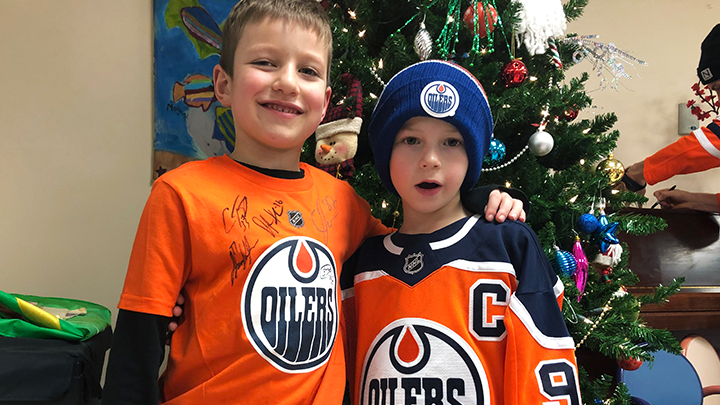
December 17, 2019

Avid Edmonton Oilers fans Paxton Scriven, left, and Brayden Pelletier share a special bond after both experienced strokes in 2018. Both also attended Glenrose Rehabilitation Hospital where they worked on their speech and movement challenges with occupational therapy. Despite living an hour’s drive apart, their families have found support in each other’s journey to recovery.
Story & photo by Vanessa Gomez
Although they live an hour’s drive from each other in Drayton Valley and Sturgeon County, the Pelletier and Scriven families became united by a shared experience — their six-year old sons Brayden Pelletier and Paxton Scriven both suffered strokes in 2018, just a month apart.
“It was quite a whirlwind being in the hospital, having so many tests and people coming in and out,” says Paxton’s mother, Carleigh Scriven.
Both boys spent time at the Stollery Children’s Hospital before coming to the Glenrose Rehabilitation Hospital to work on the new challenges they faced.
Brayden’s stroke affected his right side, leaving it weak. As well, he required speech therapy to improve his word recall. Paxton’s stroke meant he had to relearn how to walk, while receiving therapy to strengthen his left side.
Unaware of each other’s struggles, the families came together through a mutual friend who introduced them, in light of their similar circumstances. Since that day, they’ve leaned on each other for support as they share in their boys’ challenges and victories.
“It’s nice to have that friendship with someone that you can talk you,” says Karen Pelletier. “Reaching out for help when you need it and leaning on friends and family is so important.”
Dr. Jerome Yager, a pediatric neurologist and director of the Northern Alberta Stroke Program, says that strokes are much more common in pediatric patients than people might think, but the difficulty lies in diagnosing them.
“In children, there are several possibilities as to why they may be unable to move their right or left side — anything from a disorder of the brain, a migraine or seizure. Are all possibilities, which makes treatment difficult,” adds Dr. Yager. “We should still seek immediate medical attention if these symptoms present themselves. Early intervention is key.”
While awareness of stroke in the pediatric population is growing, Dr. Yager and his team have made remarkable gains in rehabilitation and the prevention of stroke reoccurrence.
Thanks to the innovative therapies at the Glenrose — with methods such as hydrotherapy, bimanual games and fun, child-centred activities like Nerf guns and snowman building — Brayden and Paxton have bounced back quickly. They even showed off their improved speech and movement skills to the NHL hockey pros during the annual Edmonton Oilers Christmas visit.
“We incorporate current and available technologies, such as touch screens and gaming systems, into our treatment programs with the vision of keeping children interested and challenged,” says Megan Bulat, an occupational therapist at the Glenrose. “We want to keep them engaged and motivated as they work to reach their therapeutic goals.”
In addition, Bulat works to make sure activities are accessible, and the kinds of things that families can do together at home after discharge.
“Engaging families in these activities ensures the rehabilitation continues after they’ve left the Glenrose,” she adds. “It’s empowering for them to be a part of the recovery journey.”
For now, the Pelletiers and Scrivens are planning to enjoy some time together in the new year, as they continue to grow their friendship and mutual support.
“I think Paxton knows he’s different from other kids now,” says Carleigh. “But Brayden is kind of the same as him — and they will always share this connection.”